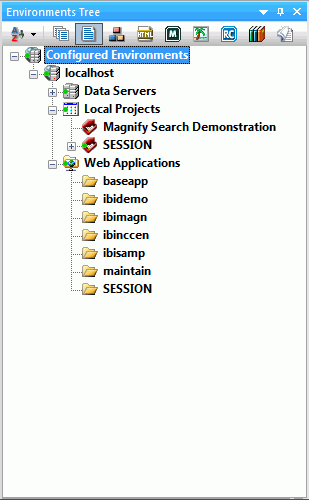
In this section: |
From the Environments Tree panel, you can:
The Environments Tree panel is shown in the following image.

The Environments Tree panel opens with App Studio.
For more information on customizing the Environments Tree panel, see Using the Panel Customization Options.
The Environments Tree toolbar contains the buttons and menus that you need to navigate, filter, and sort the information that appears in the Configured Environments tree.
Presents options for viewing items (for example, alphabetical sorting or grouping), as described in the following table.
|
Option |
Name |
Function |
|---|---|---|
|
|
View items sorted in Alphabetical order |
Sorts the files alphabetically from A to Z. |
|
|
View items sorted in reverse Alphabetical order |
Sorts the files alphabetically from Z to A. |
|
|
View items sorted in Chronological order |
Sorts the files by the last saved time, in descending order. |
|
|
View items sorted in reverse Chronological order |
Sorts the files by the saved time, in ascending order. |
|
|
View Items grouped by File Type |
Sorts the files by file type. |
|
|
View items by Title |
Displays the files by title and sorts the files by title. If an item does not have a title, its name is shown. |
|
|
View items by Name |
Displays the files by name and sorts the files by name. If an item does not have a title, its name is shown. |
|
|
Show All Files in Associated Paths |
Toggles between showing files that belong to the Project or folder, or files that are visible in paths associated with the Project or folder. Available only in the Local Projects and repository nodes. Note: A red line appears to the left of the files that are not added to a Project or folder, but are visible in the paths associated with the Project or folder. |
|
Refresh View |
Refreshes the files and folders that you see in the Configured Environments tree. Refresh View also shows the dependencies of the file or folder that you have selected. | |
|
|
Show All files |
Filters the tree to show all file types. |
|
|
Show only Procedure files |
Filters the tree to show only this file type. |
|
|
Show only Master files |
Filters the tree to show only this file type. |
|
|
Show only HTML files |
Filters the tree to show only this file type. |
|
|
Show only Maintain files |
Filters the tree to show only this file type. |
|
|
Show only Image files |
Filters the tree to show only this file type. |
|
|
Show only ReportCaster files |
Filters the tree to show only this file type. |
|
|
Show only Library files |
Filters the tree to show only this file type. |
|
|
Other files |
Filters the tree to show only this file type. |
In this section: |
The Configured Environments tree displays the WebFOCUS Environments, Data Servers, Local Projects, and Web Applications nodes. If you have the Managed Reporting version of App Studio and WebFOCUS Release 8.0 Version 05 or higher installed on your machine, or configured a remote WebFOCUS 8 environment, a repository node also appears.
If a node under the Configured Environments Tree has been populated and contains content, a green dot is shown on the node icon. If a node has been populated and does not contain any content, a red dot is shown on the node icon. If a node has not been populated, App Studio does not know if there is any content in that node and no dot is shown on the node icon. If you create a new content in a node with a red dot on it, that node now has content in it and will change to a green dot. If you delete all content in a node with a green dot, that node now has no content in it and will change to a red dot.
Note: By default, the Configured Environments tree sorts files and folders by title. If you change the sorting options to View Items by Name, the names of your files and folders will display. Whether you display content by title or by name, the Content, Data Servers, Local Projects, and Web Applications nodes do not display differently.
You can expand the nodes on the Configured Environments tree to view your configured environments, projects, folders, and application files. Use the filtering commands on the toolbar to sort files alphabetically, display by name or title, or include the associated paths.
From the Configured Environments tree, you can manage content for each of your WebFOCUS environments. This includes creating new folders or files, opening existing files, and copying files. Right-click a node, folder, or file to view the shortcut menu of options. You can also open files by double-clicking them.
Note:
You can use the shortcut menu on any file, select New, and click the type of content you want to create, to create new content in the same location.
If a Master File is located in a nested folder (for example, folder xyz is within folder abc), you must first use the Reporting Server Console to map the nested application folder as a new application.
You can copy files from your desktop to the Configured Environments Tree.
From the Configured Environments node, you can access the following shortcut menu option:
Add. Opens the WebFOCUS Environments Properties dialog box where you can add additional environments.
From your WebFOCUS environment, in the Environments Tree panel, you can access the following shortcut menu options:
Sign In. Allows you to sign in to your WebFOCUS environment. This option is only available if you are not already signed in to your WebFOCUS environment.
Sign Out. Allows you to sign out of your WebFOCUS environment. This option is only available if you are already signed in to your WebFOCUS environment.
Note: You can copy files that are not in App Studio and paste them in the Configured Environments tree to use those files when creating your application.
For more information, see WebFOCUS Environment Properties.
The Data Servers node lists each Reporting Server that the WebFOCUS Client can access. This node expands to display the files that you can use to develop WebFOCUS applications successfully.
From the Applications folder or a file, you can access the following shortcut menu options:
New Application. Creates a new application folder.
Configure Application Path. Opens the Application Path dialog box from which you can create applications, add applications to the search path, map and reorder applications, delete applications or mappings from the path.
Show Applications in Path. Shows all applications that are in the designated path.
From an application folder, you can access the following shortcut menu options:
New. Creates a new folder or file. The following shortcut menu options are available when pointing to New:
Procedure. Creates a new procedure folder in the your current application folder.
Report. Creates a new report.
SQL Report. Creates a new SQL report.
Chart. Creates a new chart.
SQL Chart. Creates a new SQL chart.
HTML/Document. Creates a new HTML page or document.
XML Document with ESRI Configuration. Creates a new XML document using an ESRI configuration.
Application. Creates a new application folder in your current application folder.
Paste. Pastes cut or copied folder or file.
Rename. Changes the name of the selected folder or file.
Delete. Deletes the selected folder or file.
For more information, see How to Add a New Project.
From a Master File the following shortcut menu options are only available in the Data Servers area:
Configure Application Path. Allows you to edit the application path of a Master File. This option is unavailable if you do not have the appropriate access privilege.
You can use the a Local Projects node to develop content if, during installation, you used a serial number that allows project development. The Local Projects node is part of the Configured Environments tree. It helps you organize, develop, maintain, and deploy WebFOCUS applications as a project.
Local Projects does not require the web-tier APPROOT and the Reporting Server APPROOT to match. This is only necessary if you are developing content that requires the use of the Reporting Server. An example of content that uses the Reporting Server would be an HTML Page that runs procedures
If the APPROOTs do not match you will still see the Local Projects node and can create new projects. However, the content you create can only be saved on the web tier and cannot access Reporting Server files. An example of this type of content would be an HTML page that does not run procedures.
You can uncheck the option, Start local Reporting Server, in the App Studio Options dialog box, and if you try to create Reporting Server content, such as a report, you will receive an error when selecting a Master File.
You can specify a Reporting Server to use for project development in the Environments List dialog box.
From a project folder, you can access the following shortcut menu options:
New Project. Creates a directory in which you store your procedures. Opens the New Project dialog box which facilitates the creation of your new project.
From an application folder or a file, you can access the following shortcut menu options:
Paste. Pastes cut or copied folder or file.
Rename. Changes the name of the selected folder or file.
Delete. Deletes the selected folder or file.
New. Creates a new file. The following shortcut menu options are available when pointing to New:
Procedure. Creates a new procedure folder in the your current application folder.
Report. Creates a new report.
SQL Report. Creates a new SQL report.
Chart. Creates a new chart.
SQL Chart. Creates a new SQL chart.
HTML/Document. Creates a new HTML page or document.
Maintain Procedure. Creates a new Maintain file.
Synonym. Creates a new Master File after you have selected a configured adapter, or configure a new adapter.
Synonym via Metadata Canvas. Creates a new Master File in the Metadata canvas.
Define Function Library. Creates a user-defined function library. Any user-defined functions created in this library are available for use in any content created within the same folder as the library. After the creation of the first function, you can create additional functions or editing existing ones. Once the initial function library is created, future additions or modifications are done through the Procedure View panel.
For more information, see How to Add a New Project.
The Repository node is storage space for data or information, and allows you to use App Studio to administer and develop against a Managed Reporting environment. The Repository node lets you manage resources and applications on remote servers, as well as on your local machine if you have performed a full installation of App Studio. You can create and edit application files on all remote servers from one easily accessible interface. You can also create and administer reports for Managed Reporting from a Windows application rather than a web browser.
From a repository node, you can access the following shortcut menu options:
New Folder. Creates new folder.
Mode Manager. Allows you to edit private files, if you have the proper authorization setting.
Hide/Show. Allows you to hide or show a folder to a user. You can also change this option from the File/Folder Properties panel by changing the Do not show on user’s list property.
Security. Enables you to control user permissions, which limit what development areas a user can access.
ReportCaster Explorer. Opens the ReportCaster Explorer.
From a folder or file, in the repository, you can access the following shortcut menu options:
New. Creates a new file. The following shortcut menu options are available when pointing to New:
Procedure. Creates a new procedure folder in your current application folder.
Report. Creates a new report.
SQL Report. Creates a new SQL report.
Chart. Creates a new chart.
SQL Chart. Creates a new SQL chart.
HTML/Document. Creates a new HTML page or document.
Visualization. Creates a new chart, map, or grid.
Alert. Creates a new alert.
Reporting Object. Creates a new reporting object.
URL. Creates a new URL.
Cascading Style Sheet. Creates a new Cascading StyleSheet.
WebFOCUS StyleSheet. Creates a new WebFOCUS Stylesheet.
Text Document. Creates a new text document.
Schedule. Creates a new schedule.
Distribution List. Creates a new distribution list.
Library Access List. Creates a new library access list.
Folder. Creates a new folder.
Publish. Enables you to publish a selected folder within the repository.
Unpublish. Enables you to unpublish a selected folder within the repository.
Security. Enables you to control user permissions, which limit what development areas a user can access.
Rename. Changes the name of the selected folder or file.
Delete. Deletes the selected folder or file.
ReportCaster Explorer. Opens the ReportCaster Explorer.
Note: For more information on publishing and unpublishing folders and items within the repository, see the WebFOCUS Security and Administration manual.
The Web Applications node allows you to open files with the Text Editor, or the mode you used to create them.
Note: Based on the file type, different options may display.
From the Web Applications node, you can access the following shortcut menu options:
New Application. Creates a new application folder.
From an application folder, you can access the following shortcut menu options:
Rename. Changes the name of the selected folder or file.
Delete. Deletes the selected application folder.
New. Creates a new file. The following shortcut menu options are available when pointing to New:
HTML File. Creates a page in html format. You can import existing HTML content, as well.
JavaScript File. Creates a new JavaScript file from which you can create original JavaScript.
Cascading Style Sheet. Creates a base template from which you can create a unique Cascading Style Sheet (CSS).
Delete. Deletes the selected folder or file.
Properties. Displays the folder properties in the File/Folder Properties panel.
From a file, you can access the following shortcut menu options:
Open in Text Editor. Opens the file in the Text Editor canvas.
New. Creates a new file. The following shortcut menu options are available when pointing to New:
HTML File. Creates a page in html format. You can import existing HTML content, as well.
JavaScript File. Creates a new JavaScript file from which you can create original JavaScript.
Cascading Style Sheet. Creates a base template from which you can create a unique Cascading Style Sheet (CSS).
Delete. Deletes the selected folder or file.
Copy. Copies the selected file to the clipboard where you can paste it to a different node.
Rename. Changes the name of the selected file.
Delete. Deletes the selected file.
Properties. Displays the folder properties in the File/Folder Properties panel.
Population is a check to see what content, if any, is contained within a node in the Configured Environments tree. Node population occurs when you select a node in the Configured Environments tree. The node icon will be different depending on whether population has occurred. If a node contains files after population a green dot appears on the node icon. If a node does not contain files after population, a red dot appears on the node icon.
|
Icon |
Description |
|---|---|
|
|
If a node has not been populated. |
|
|
If a node has been populated and contains content. |
|
|
If a node has been populated and does not contain files. |
If a node has been populated and contains content, deleting that content will change the green dot to a red dot. Conversely, if a node has been populated and contains no content, creating content in that node will change the red dot to a green dot.
The following shortcut menu options are available for a Master File:
Note: When a Master File is opened in the Text Editor canvas or the Metadata canvas, all other open options from the shortcut menu are unavailable.
In addition to opening files through the Application menu, or from the Quick Access Toolbar, you can also open files from the development areas in the Configured Environments tree.
Note: Files can only be opened in one area of App Studio at a time to ensure that your changes are not overwritten by another opened version of the file. However, you are able to open a file in App Studio and in a Windows Associated Tool at the same time. To ensure that your changes are saved properly, you should only modify one opened version of the file at a time.
As you set up access to WebFOCUS environments, your settings are retained in a file named wfscom.xml. WebFOCUS environment settings are typically stored in the following locations.
Windows 7:
drive:\Users\user_id\ AppData\Roaming\Information Builders\wfscom.xml
where:
Is your Windows user ID.
Note:

You can choose to remove this environment from your configuration files or leave the environment, and continue to develop against other environments that you configure. If you choose to remove the environment from your configuration files, you must restart App Studio.
A WebFOCUS environment consists of a web server, a WebFOCUS Client, and a Reporting Server. Adding WebFOCUS environments lets you create and manage multiple environments, such as development, test, and production instances.
To add a WebFOCUS environment, do the following:
The following procedure provides the information you need to add a WebFOCUS Environment.
The Environments List dialog box opens, as shown in the following image. This dialog box lists all WebFOCUS environments defined for App Studio.
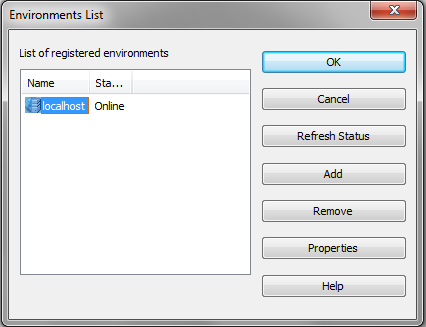
The WebFOCUS Environment Properties dialog box opens, as shown in the following image.

At the top of the dialog box is the Description field, followed by the Environments Settings area. The Environments Settings area contains a series of buttons that represent components in a WebFOCUS environment, and the required parameter fields to configure that environment. When you configure an environment, the areas below the buttons can change according to the parameters that are required.
Note: The description cannot contain special characters, such as ., /, \, ?, *, and others. A message with characters not allowed appears if one of the restricted characters is detected during validation.
For some environments, once you specify the web server, all other settings default. If the WebFOCUS environment you are accessing does not use default settings, or the components require authentication, click the appropriate button in the Environment Settings area to provide the parameters. The areas that follow explain the parameters available for each component.
Note: WebFOCUS environment properties must be supplied in a specific order. For example, if web server security is enabled, you cannot set the WebFOCUS Client script name until you have provided valid web server credentials. Similarly, you cannot retrieve a list of Reporting Servers until you have provided a valid WebFOCUS Client Path.
As you select a component button in the WebFOCUS Environment Properties dialog box, App Studio ensures that it has the necessary information before it displays the properties of that component in the lower part of the dialog box. If the required information is not available, you cannot proceed to the next component.
The WebFOCUS Logon - WebFOCUS dialog box, shown in the following image, opens and prompts you for a WebFOCUS ID and password.
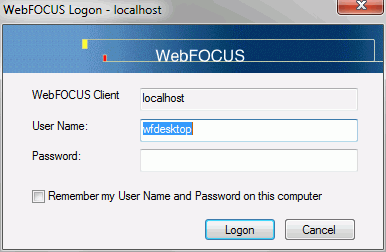
The WebFOCUS logon dialog box populates the ID wfdesktop, by default. This user ID is configured with WebFOCUS and allows self-service development: development from the Local Projects, Data Servers, and Web Applications area.
Access to the Repository is restricted, and you cannot create new content with this user ID. You can only see and run published content.
There is a check box option on the logon dialog box for remembering the ID or password. By default, it is not selected. If you select this box, your credentials are stored and encrypted in the wfscom.xml file, the local configuration file that stores information processed by the App Studio communication layer.
To clear stored credentials, open the WebFOCUS Environment Properties dialog box and select the environment that users need to make changes. Click WebFOCUS Client. Under WebFOCUS Credentials, delete the User ID and Password information, and then clear the Supply Credentials check box.
Note: A logon dialog box can also opens for connection to the web server, application server, or Reporting server, depending on the security implemented in the WebFOCUS environment that is being accessed.
Local Machine properties are optional. Click the Local Machine button to access the WebFOCUS Environment Caching area. Select the options in this area to cache remote directory and file information, and enable file-content caching.
The following image shows the WebFOCUS Environment Caching area of the WebFOCUS Environment Properties dialog box. The file content caching location path is for a Windows 7 machine.
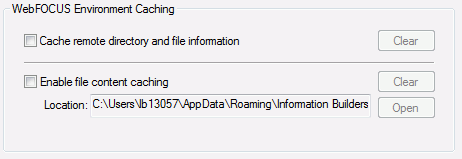
In caching, copies of files or information stored on a remote machine are temporarily stored on your local App Studio machine. App Studio then works with the locally stored files.
Caching speeds App Studio performance because remote machines are not accessed and queried every time you request information. This is especially useful when accessing mainframes or when a network connection is slow.
However, caching should not be used when multiple developers are working with the same files because they could overwrite changes made by other developers. By default, caching is not enabled.
Two properties are available:
App Studio retrieves information and files the first time you request them and then caches them locally. App Studio then uses the cached copies until App Studio is restarted, or you click the Clear buttons for each level.
Note:
The Web Components button is typically selected by default. Web Component properties specify how App Studio accesses the web server. The web server must be identified before any other components. The following image shows the Web Component area of the WebFOCUS Environment Properties dialog box.
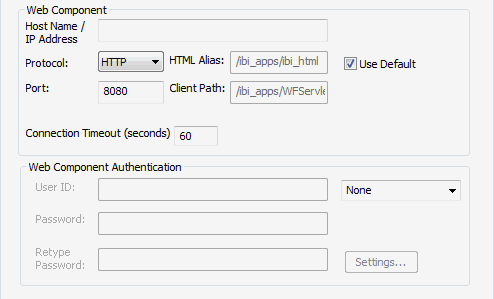
The following properties are available:
/ibi_apps/ibi_html
where:
Is customizable.
Is constant.
/ibi_apps/WFServlet
where:
Is customizable.
Is constant.
If the WebFOCUS environment uses a non-default context path, clear the Use Default check box and provide the correct Client Path. For example:
/ibi_apps8/WFServlet
If the Client Path is incorrect for the environment, you receive an error when you click the WebFOCUS button at the top of the page, or when you click OK to exit and save your changes.
If you do not know your path, ask your WebFOCUS Administrator or check the WebFOCUS Administration Console of the environment to which you want to connect. The Client Path settings for the environment are located under Utilities and Client Selection.
Use Default. Specifies that the default ibi_html alias is used. Keep this option selected unless you change the HTML Alias value.
Note:
HTML Alias:
/ibi_apps8/ibi_html
Client Path:
/ibi_apps8/WFServlet
For more information, see the WebFOCUS Security and Administration manual.
When you click the WebFOCUS button, App Studio makes a connection to your web server to retrieve information about the WebFOCUS environment. Therefore, you have to first specify Web Component properties, and your web server must be running. The following image shows the WebFOCUS area of the WebFOCUS Environment Properties dialog box.
You are prompted to sign in to WebFOCUS to verify your configuration. You will also be prompted to sign in to WebFOCUS if you click OK to exit the dialog box.
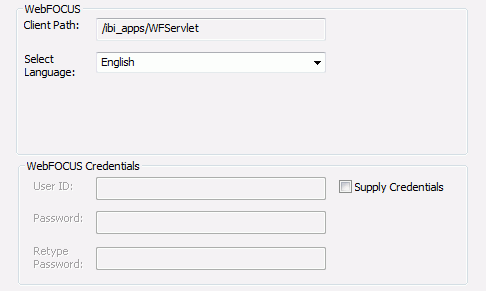
The following properties are available:
When the correct WebFOCUS Client Path is provided, you can specify properties for the remaining component.
Managed Reporting and ReportCaster properties are not available in this version of App Studio.
You can set authentication and view available Reporting Servers by clicking the Data Servers button. When you select Data Servers, App Studio connects to the WebFOCUS Client and retrieves a list of servers from its communication configuration file (odin.cfg).
The following image shows the WebFOCUS Data Servers area of the WebFOCUS Environment Properties dialog box.
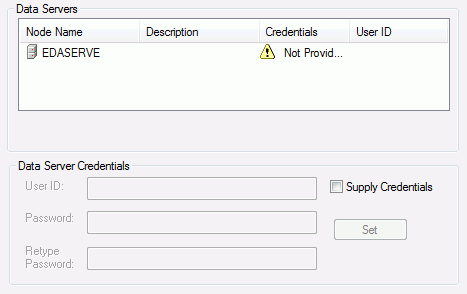
The following property is available:
Note: These properties only apply to self-service application development, and when performing project development.
If you use remote Project-based development and your remote environment has multiple Reporting Servers, click the Project Development button to specify which server to use when processing requests. This server is referred to as the Project Development Server. The Project Development Server and the WebFOCUS Client must be installed on the same machine or use the same Application Root directory (APPROOT directory) as each other.
The following image shows the Project Development Server area of the WebFOCUS Environment Properties dialog box.
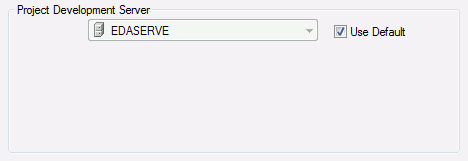
The following property is available:
The Environments List dialog box opens, as shown in the following image.

The WebFOCUS Environment Properties dialog box opens, as shown in the following image.

To add a project to the Local Projects node:
The Create a Project wizard opens.
In the Create a Project - Step 1 of 2 dialog box, you can:
The location and name of the new project displays at the bottom of the dialog box.
A message displays if the directory does not exist.
The Create a Project - Step 2 of 2 dialog box opens.
From this dialog box, you can add other directories to the project path. Project files in those directories are visible to the project and are accessible for development.
Repeat this step to add more directories to the project path.
The new project now appears under the Local Projects node.
You can update the directory folders associated with a Project after you create it by right-clicking the Project and selecting Properties. The Properties dialog box opens, click the Paths tab. In the Related Application Paths area, you can add, delete, and reorder the directory folders. Click OK to accept the changes.
If you have the manage private resources permission, you can use Mode Manager to view and edit private files. To enable Mode Manager, right-click on the Repository node and click Mode Manager. Your view refreshes, displaying all private files in the Repository. You can open and make changes to these private files as needed. When you are finished, right-click on the Repository node and click Mode Normal. Your view refreshes, hiding the private files in the Repository node.
Note: When a file in the Repository is marked as shared, and you do not have permission to save the original file, you will only be allowed to use the Save As command to save the file. This will allow you to save the file under a different name, leaving the original file untouched.
| WebFOCUS |